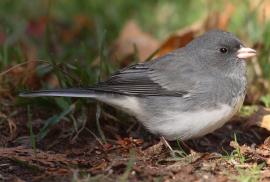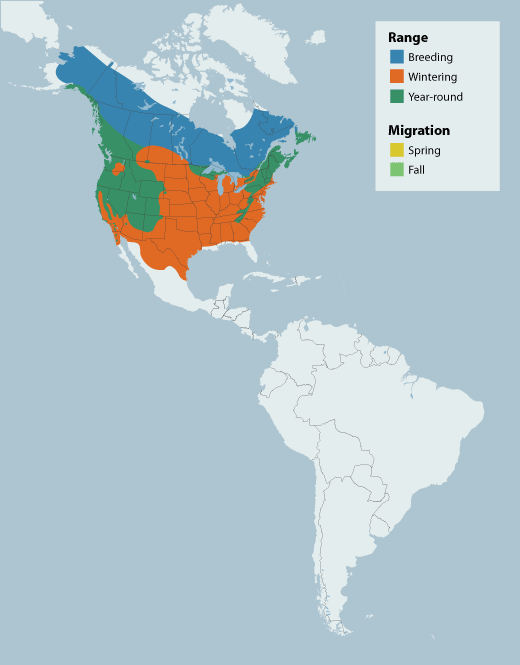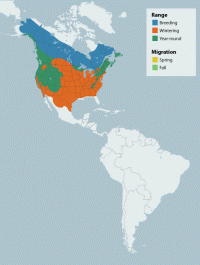Guide to Boreal Birds
This is an in-depth boreal species profile.
What is this?
This species is one of more than 30 birds selected for in-depth profiles. Find out why and see all selected boreal birds »
Overview
Breeding and/or wintering virtually throughout the continental U.S. and Canada, the Dark-eyed Junco, sometimes called the "Snowbird," is one of the most familiar birds at North American bird feeders. It is also one of the most variable, with 15 subspecies in five distinguishable groups that differ from one another sufficiently in size, proportions, plumage, vocalizations, migration patterns, and ecology that they once were considered distinct species (Slate-colored, Oregon, Gray-headed, White-winged, and Guadalupe Juncos). This lively territorial bird is a ground dweller and feeds on seeds and small fruits in the open. It also moves through the lower branches of trees and seeks shelter in the tangle of shrubs. It is abundant in the boreal forest during the breeding season.
Description
5-6 1/4" (13-16 cm). This species shows much geographic variation in color. Typically, male of western population ("Oregon Junco") has black hood, chestnut mantle, white underparts with buff sides. Eastern male ("Slate-colored Junco") is dark slate-gray on head, upper breast, flanks, and upperparts, with white lower breast and belly. Both forms have pink bill and dark gray tail with white outer tail feathers conspicuous in flight. The pine forests of the Black Hills in western South Dakota and eastern Montana have an isolated population ("White-winged Junco") similar to the eastern form but with 2 white wing bars and extensive white outer tail feathers. Birds of the Southwest ("Gray-headed Juncos") are gray overall, with a reddish-brown back. Female "Oregon Junco" has gray hood; females of all forms less colorful.
Voice
Ringing metallic trill on the same pitch. Members of a flock may spread out widely, keeping in contact by constantly calling tsick or tchet. Also a soft buzzy trill in flight.
Nesting
3-6 pale bluish or greenish eggs, with variegated blotches concentrated at the larger end, in a deep, compact nest of rootlets, shreds of bark, twigs, and mosses, lined with grasses and hair, placed on or near the ground, protected by a rock ledge, a mud bank, tufts of weeds, or a fallen log.
Habitat
With such a broad range and variable ecology, it is not surprising that the Dark-eyed Junco occurs in a staggering array of habitats. In the boreal region, it nests in both coniferous and hardwood forests, especially those with relatively sparse tree cover and dense understory. Elsewhere, it occurs in virtually any habitat with sufficiently dense low vegetation for nesting. Throughout its breeding range, it seems to respond favorably to events such as fire and logging that restart forest succession, resulting in increased density of shrub and ground cover. During migration and winter it can be found in an even broader range of habitats, including areas with relatively little cover such as harvested crop fields, grassy lakeshores, lawns, and road margins.
Range/Migration
Most (including all northern) populations are migratory. The peaks of migration are in October and March/April. The winter range extends across southern Canada and virtually all of the lower 48 states into northern Mexico. Juncos are found year-round throughout much of the West, Great Lakes region, Northeast, and Appalachians, though these areas experience complete or partial turnover of individuals. Adults, especially females, tend to migrate farther (and begin migration earlier) in eastern populations. For example, winter junco flocks are 20 percent female in Michigan and 72 percent female in Alabama. Western flocks are less segregated due to greater mixing of populations. Some montane populations exhibit altitudinal migration, with age and sex differential mirroring that of latitudinal migration. Female mortality is probably higher than that of males during migration due to the greater distance but lower in winter because of milder weather; thus, net survivorship and sex ratios on the breeding grounds are about equal. Migration is typically at night. Flock composition probably changes from day to day during migration; individuals apparently seek one another out for group foraging and roosting during the day and may depart en masse at night but do not stay together during flight.
Breeding
Sixty-six percent of the global population of Dark-eyed Junco breeds in the boreal forest of North America. The Slate-colored form nests throughout the boreal region, from the shores of the Bering Sea to the Atlantic, and south through the Appalachians. Other forms nest throughout the western mountains to northern Baja California and west Texas. The breeding system of the Dark-eyed Junco is categorized as "social monogamy." Although birds of both sexes tend to have only one "social mate" with which they nest and defend a territory, they frequently copulate with neighboring birds. As a result, males raise many young that are not their own. Females that lose their mates quickly re-pair, often with neighboring males who may sire broods with their new mates while also rearing young with their original mates. Such males rarely care for their new mates' original young, even though some likely are their own offspring. The nest is usually on the ground, often on a sloping bank, and concealed under a protruding rock, among roots, under a log, or at the base of plant stems, but occasionally in a tree. Usually four eggs are laid, with larger clutches more frequent early in the season and smaller clutches late. The young are able to run before they can fly, if necessary, because their legs develop quickly. Southern populations normally attempt to raise two broods per year. Nest predation, particularly by rodents, is very high, and overall productivity is highly correlated with rodent density.
Diet/Feeding Behavior
The Dark-eyed Junco is similar to many other sparrows in its diet and foraging ecology. Winter diet is primarily weed and grass seeds but occasionally small fruits and waste grains; breeding-season diet is primarily insects and spiders, more or less in proportion to availability. On a year-round basis, the diet is usually about three-fourths seeds and one-fourth arthropods. Juncos employ a variety of foraging methods, including gleaning, pecking, and scratching. The species forms flocks, often numbering in the hundreds, outside the breeding season; these flocks are strongly hierarchical, with larger birds dominant over smaller ones and older birds over younger ones. Thus, males, which are larger, typically dominate females, adults are dominant over young birds, and large subspecies dominate smaller ones where they coexist. Foraging behavior shows typical risk-avoidance characteristics, with individual birds becoming less vigilant with increasing light intensity (when predators are less likely to attack) and flock size. Well-fed birds are less risk-averse than hungry ones.
References
Balph, M.H. 1979. Flock stability in relation to social dominance and agonistic behavior in wintering Dark-eyed Juncos. Auk 96:714-722.
Blancher, P. 2003. Importance of Canada's boreal forest to landbirds. The Canadian Boreal Inititative and the Boreal Songbird Initiative.
Ketterson, E.D., and V. Nolan, Jr. 1982. The role of migration and winter mortality in the life history of a temperate-zone migrant, the Dark-eyed Junco, as determined from demographic analyses of winter populations. Auk 99:243-259.
Nolan, V., Jr., E.D. Ketterson, D.A. Cristol, C.M. Rogers, E.D. Clotfelter, R.C. Titus, S.J. Schoech, and E. Snajdr. 2002. Dark-eyed Junco (Junco hyemalis). InThe Birds of North America, No. 716 (A. Poole and F. Gill, Eds.). Philadelphia: The Academy of Natural Sciences; Washington, D.C.: The American Ornithologists' Union.
Sauer, J.R., J.E. Hines, and J. Fallon. 2003. The North American Breeding Bird Survey, Results and Analysis 1966-2002, Version 2003.1, USGS Patuxent Wildlife Research Center, Laurel, MD.
National Audubon Society. 2002. The Christmas Bird Count Historical Results [Online]. http://www.audubon.org/bird/cbc.
Smith, K.G., and D.C. Andersen. 1982. Food, predation, and reproductive ecology of the Dark-eyed Junco in northern Utah. Auk 99:650-661.
Credits
Birding content provided by National Wildlife Federation/eNature, with support from Ducks Unlimited/The Pew Charitable Trusts.





